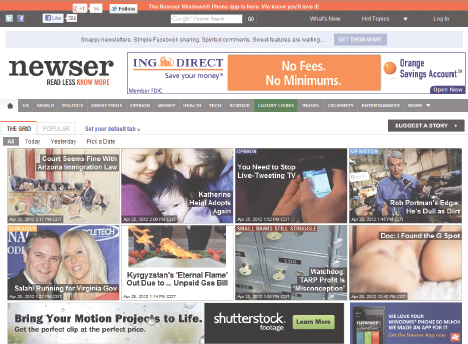Printed Page 86
CONVERGING MEDIA
Case Study
News Aggregation

“Frankly, the New York Times is a bore. As are actually most news organizations which continue to write for an older world. I mean, the New York Times writes as though one is only reading the New York Times.” 1
These fighting words were spoken by Michael Wolff, editorial director of Adweek and founder of Newser. Like the Drudge Report and the Huffington Post, Newser thrives on a new type of content convergence called news aggregation, in which a site packages news summaries, usually providing links to the sources from which it draws (such as online versions of a newspaper, magazine, or wire service). The Drudge Report is the oldest and most famous of these sites. With a Web 1.0 look, the Drudge Report presents links to news reports, opinion pieces, and blogs with a general conservative bent. The Huffington Post (bought by AOL in 2011), though claiming to be independent, often reverses Drudge’s partisanship with a liberal slant. Newser steers clear of partisanship, branding itself as “a news curator with a kick.” The site reduces the long, “boring” stories from, say, the New York Times to summaries with links to the original reports, intended to be readable in a variety of formats: desktop, laptop, mobile device.
In recent years, news aggregators have come under public attack for promoting a form of journalism that only takes and gives nothing back. In September 2009, media entrepreneur Mark Cuban took aim at Newser, declaring that major media companies should use software that blocks links, thus preventing hyperlink access to the offending sites.2 Wolff’s response, “Mark Cuban is a Big Fat Idiot—News Will Stay Free,” claimed Newser should be thanked, not condemned, because some readers click through to the original stories.3
A year later, it was Arianna Huffington’s time to deflect the barbs of an Old News representative. In a lecture, former executive editor of the Washington Post Len Downie named the Huffington Post as an example of a news media “parasite,” condemning news aggregation as thievery.4 Huffington dismissed his concerns: “Once again, some in the old media have decided that the best way to save, if not journalism, at least themselves, is by pointing fingers and calling names.”5
As the name-calling feuds suggest, media convergence often arouses passion and arrogance on both sides of the new/old media divide. But we don’t have to pick sides to recognize the paradox of Wolff’s declaration that “the news will stay free.” Despite his argument that he provides a service to his hosts, Wolff doesn’t pay any newsroom salaries. As such, it’s possible that news aggregation could help hasten the demise of businesses that do actually pay reporters—after all, if there’s no one to report and write up the news, there will be nothing for the aggregators to aggregate. Clearly audiences are seeking new forms of journalism, and many media companies are working to find a model that makes financial sense. What’s not yet clear is where this process will leave organizations like Newser—or their audiences.